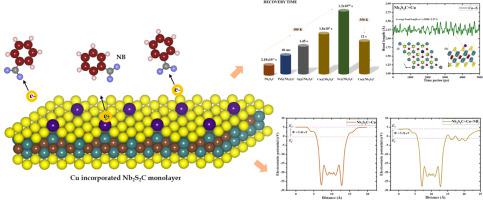当前位置:
X-MOL 学术
›
Surf. Interfaces
›
论文详情
Our official English website, www.x-mol.net, welcomes your feedback! (Note: you will need to create a separate account there.)
Cu-incorporated novel 2D Transition metal carbo chalcogenide Nb2S2C monolayer for Superior Nitrobenzene sensing: A theoretical study
Surfaces and Interfaces ( IF 6.2 ) Pub Date : 2024-03-15 , DOI: 10.1016/j.surfin.2024.104209 Seetha Lakshmy , Nandakumar Kalarikkal , Brahmananda Chakraborty
Surfaces and Interfaces ( IF 6.2 ) Pub Date : 2024-03-15 , DOI: 10.1016/j.surfin.2024.104209 Seetha Lakshmy , Nandakumar Kalarikkal , Brahmananda Chakraborty

|
Two-dimensional transition metal carbo-chalcogenides (TMCC), a very new class of synthesized 2D family having combined properties of TM metal carbides and TM metal di-chalcogenides, can be considered for the detection of industrial toxic effluents like Nitrobenzene (NB). In this work, we report a potential sensor, TMs (Pd, Ag, Cu, and ) incorporated NbSC monolayer, for detecting NB employing density functional theory (DFT) simulations. The findings reveal that NB exhibits only physisorption on pristine NbSC (adsorption energy=-0.2 eV). Among the TMs considered, enhanced adsorption characteristics were exhibited by the Cu-incorporated NbSC system with an adsorption energy of -0.9 eV. This weak chemisorption achieves a rapid recovery (12 s) at 350 K. The improved adsorption mechanism is due to the orbital interaction and charge transfer (0.13 e) between the 2p orbitals of NB and 4 s orbitals of Cu. The binding of the Cu on the NbSC monolayer is chemical (-2.66 eV) and is strong enough to make the system sTable The practicality of the Cu-incorporated NbSC-based sensor was assessed by analyzing work function, recovery time, thermodynamic stability, and other relevant parameters and comparing it with the pristine system. This investigation underscores the potential of Cu-incorporated NbSC as a promising candidate for NB detection, thereby contributing to the advancement of gas sensing technology. This work provides essential insights for designing and developing TMCC-based NB detectors, marking a substantial step forward in environmental monitoring and safety.
中文翻译:

掺铜新型二维过渡金属碳硫属化物 Nb2S2C 单层用于卓越硝基苯传感:理论研究
二维过渡金属碳硫属化物(TMCC)是一类非常新型的合成二维族,具有TM金属碳化物和TM金属二硫属化物的综合特性,可考虑用于检测硝基苯(NB)等工业有毒废水。在这项工作中,我们报告了一种潜在的传感器,TMs(Pd、Ag、Cu 和 )结合了 NbSC 单层,用于采用密度泛函理论 (DFT) 模拟检测 NB。研究结果表明,NB 在原始 NbSC 上仅表现出物理吸附(吸附能=-0.2 eV)。在考虑的TM中,掺Cu的NbSC系统表现出增强的吸附特性,吸附能为-0.9 eV。这种弱化学吸附在 350 K 下实现了快速恢复(12 s)。改进的吸附机制是由于 NB 2p 轨道和 Cu 4 s 轨道之间的轨道相互作用和电荷转移(0.13 e)。 Cu 在 NbSC 单层上的结合是化学结合 (-2.66 eV),其强度足以使系统稳定。通过分析逸出功、恢复时间、热力学稳定性和其他相关参数并与原始系统进行比较。这项研究强调了掺铜 NbSC 作为 NB 检测的有希望的候选者的潜力,从而有助于气体传感技术的进步。这项工作为设计和开发基于 TMCC 的 NB 探测器提供了重要的见解,标志着环境监测和安全方面向前迈出了实质性的一步。
更新日期:2024-03-15
中文翻译:

掺铜新型二维过渡金属碳硫属化物 Nb2S2C 单层用于卓越硝基苯传感:理论研究
二维过渡金属碳硫属化物(TMCC)是一类非常新型的合成二维族,具有TM金属碳化物和TM金属二硫属化物的综合特性,可考虑用于检测硝基苯(NB)等工业有毒废水。在这项工作中,我们报告了一种潜在的传感器,TMs(Pd、Ag、Cu 和 )结合了 NbSC 单层,用于采用密度泛函理论 (DFT) 模拟检测 NB。研究结果表明,NB 在原始 NbSC 上仅表现出物理吸附(吸附能=-0.2 eV)。在考虑的TM中,掺Cu的NbSC系统表现出增强的吸附特性,吸附能为-0.9 eV。这种弱化学吸附在 350 K 下实现了快速恢复(12 s)。改进的吸附机制是由于 NB 2p 轨道和 Cu 4 s 轨道之间的轨道相互作用和电荷转移(0.13 e)。 Cu 在 NbSC 单层上的结合是化学结合 (-2.66 eV),其强度足以使系统稳定。通过分析逸出功、恢复时间、热力学稳定性和其他相关参数并与原始系统进行比较。这项研究强调了掺铜 NbSC 作为 NB 检测的有希望的候选者的潜力,从而有助于气体传感技术的进步。这项工作为设计和开发基于 TMCC 的 NB 探测器提供了重要的见解,标志着环境监测和安全方面向前迈出了实质性的一步。



























 京公网安备 11010802027423号
京公网安备 11010802027423号